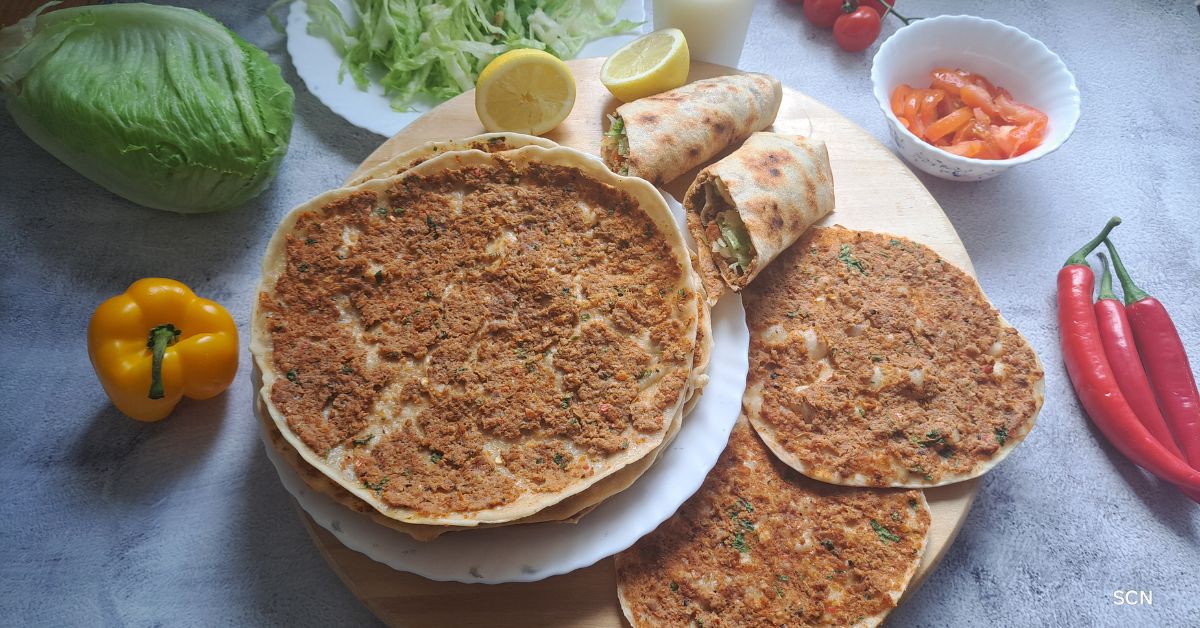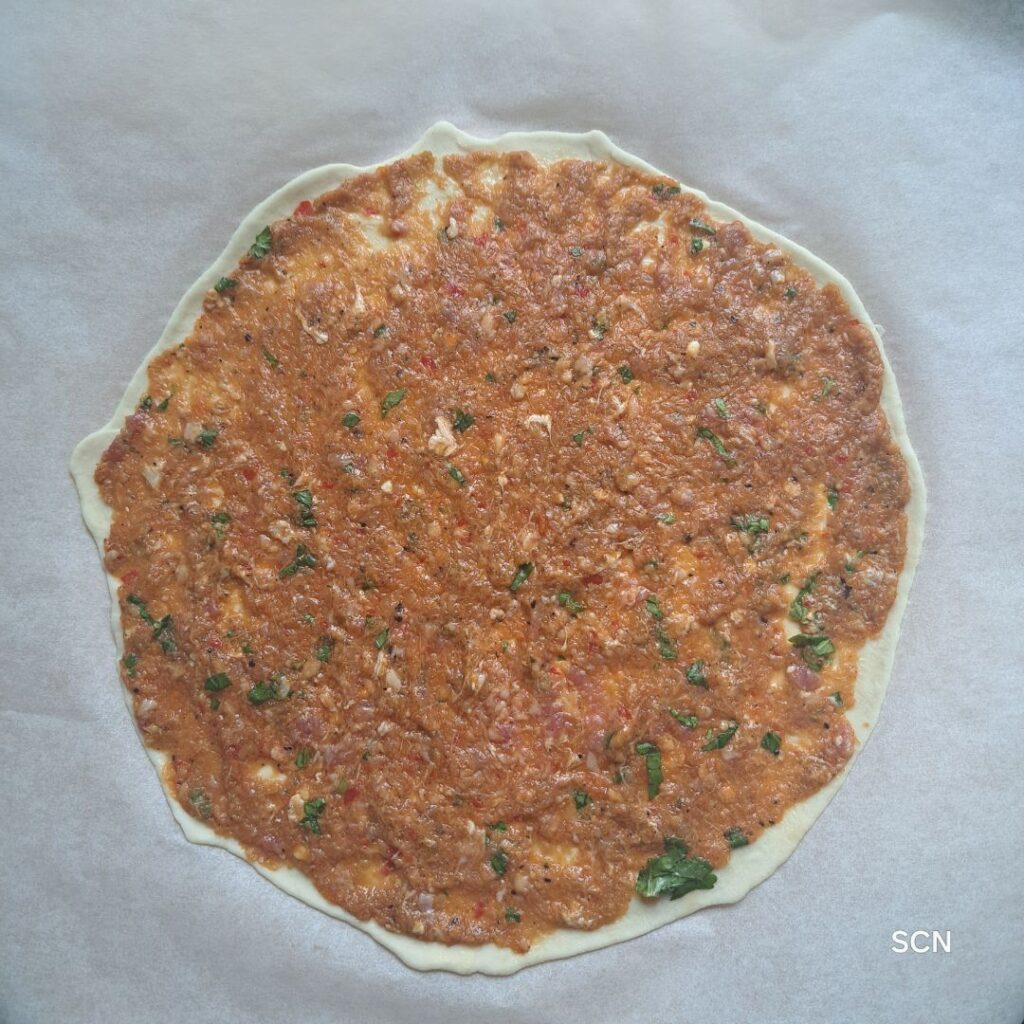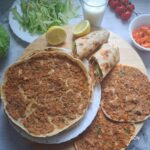LAHMACUN RECIPE

Lahmachun, also called “Turkish pizza,” is a thin, crispy flatbread with a spiced topping made from ground meat—usually lamb or beef—mixed with onions, tomatoes, garlic, and fresh herbs like parsley. The meat topping is seasoned with spices such as paprika, cumin, and black pepper to give it a rich and delicious flavour. It’s a popular street food in Turkey and many Middle Eastern countries, loved by people of all ages.
After spreading the topping, the Lahmacun is baked quickly at a high temperature until the dough is crispy and the meat is cooked perfectly. It’s served hot with fresh lemon juice and chopped vegetables or herbs on the side.
Love Lahmacun? Take it up a notch with a Meat Pide — rich, hearty, and packed with flavour!
Why is Lahmacun So Special?
What makes Lahmacun special is its simplicity and bold flavours. Unlike traditional pizzas loaded with cheese and heavy toppings, Lahmacun is light, thin, and packed with fresh ingredients. It’s also versatile — you can eat it as a quick snack, a light lunch, or a tasty dinner.
The balance between the crispy dough and the juicy, spiced meat topping creates a mouthwatering experience that’s hard to forget. Plus, it’s easy to make at home once you know the recipe!
Preparation
You can make the dough from simple ingredients, flour, water, yeast, salt, and a little olive oil. Roll out the dough very thin before spreading the topping evenly over it. The topping is a mixture of ground meat, grated onion, tomato, garlic, and spices.
Traditionally, Lahmacun is cooked in a very hot oven on a stone or metal surface. But if you don’t have an oven, you can also cook it on a stovetop pan with a lid — it still turns out deliciously crispy and flavourful.
The best way to eat Lahmacun is fresh and hot. Right after cooking, squeeze some fresh lemon juice on top and add lettuce, onions, or tomatoes. Some people like to roll it up like a wrap or fold it in half to eat with their hands.
It’s perfect for sharing with family or friends and pairs well with simple salads or yoghurt dips on the side.
Find easy and delicious bread recipes you can bake at home!
Try Making Lahmacun at Home!
If you enjoy cooking or want to try something new, Lahmacun is a great recipe to add to your kitchen. It’s simple, quick, and uses common ingredients you probably already have. Plus, it brings a taste of Turkey right to your table!
Give it a try, and you might find your new favourite homemade flatbread.

The ultimate lahmacun begins with perfectly seasoning the meat, spreading it evenly, and baking it until it turns crispy, aromatic, and irresistibly delicious!




LAHMACUN RECIPE
Ingredients
For the Dough:
- 2 ½ cups 280g bread flour
- ½ tsp salt
- 1 tsp sugar
- ¼ tsp instant yeast
- ¾ cup 200ml lukewarm water
- 1 tbsp olive oil
For the Topping:
- 250 g ground lamb or beef or a mix, 20–25% fat content
- 1 onion
- 2 cloves of garlic
- 1 medium tomato
- 1 tbsp tomato paste
- 1 red pepper
- 2 Turkish green peppers
- ¼ cup finely chopped parsley or coriander
- 1 tsp paprika
- ½ tsp ground cumin
- ½ tsp isot pepper optional
- ½ tsp black pepper
- 1 tsp salt
- 1 tbsp olive oil optional, only if the meat is leaner than 20% fat
To serve
- Lettuce leaves
- Tomato
- Lemon juice
Instructions
Make the Dough
- In a large bowl, mix flour, sugar, olive oil, salt, and yeast.
- Add lukewarm water. Knead until smooth and elastic (8–10 minutes).
- Cover and let rise for 30 minutes to 1 hour.
- Lahmacun dough does not require a long rising time. A short rest of about 30 minutes is enough to make the dough easier to work with, but it does not need to rise until doubled like typical bread dough.
Prepare the Topping
- Add the onion, peppers, and garlic to a food processor.
- Pulse until finely chopped.
- Add the tomato, spices, and minced meat to the processor.
- Blend until the mixture forms a smooth, spreadable paste.
- If using lean meat (less than 20% fat), add the olive oil to improve moisture and richness.
Stovetop Method:
- Place your dry skillet over medium heat. Let it get hot.
- Transfer the rested dough to a floured work surface and shape it into a log.
- Divide the dough into 8 equal portions (approximately 60g each). Shape them into balls and allow to rest for 15-20 minutes, covered.
- While working with one dough ball at a time, keep the remaining balls covered to prevent them from drying out.
- Roll each very thin, around 7-8 inches in diameter.
- Place a sheet of baking paper on your work surface.
- Put one rolled-out thin dough round on the paper.
- Spread a thin, even layer of the meat topping over the dough.
- Carefully lift the baking paper with the topped dough and transfer it onto the preheated pan (a cast iron or heavy skillet works best).
- Cover the pan with a lid.
- Cook for 2-3 minutes to help the topping set and the dough begin to crisp.
- After 2-3 minutes, gently slide out the baking paper, leaving the lahmacun directly in the pan to continue cooking.
- Press lightly to ensure even contact with the pan.
- Cover the pan with a lid to trap steam and help cook the meat topping evenly.
- Cook for 5–7 minutes until the bottom is golden and crispy and the meat is cooked through.
- If needed, rotate halfway through for even browning.
- You can crisp the bottom more by uncovering for the last 1–2 minutes.
- Repeat for the remaining lahmacuns.
How to Roll Lahmacun Dough Very Thin
- Lightly flour your work surface and rolling pin to prevent sticking.
- Use your hands or the rolling pin to press the dough into a rough circle.
- Begin rolling from the centre outward.
- After every couple of strokes, lift the dough gently and rotate it slightly.
- Dust with more flour as needed underneath to prevent sticking.
- It may take several passes—don’t force it in one go.
- If the dough resists stretching, let it rest for a few minutes, then continue.
- Aim for a 7–8-inch round, very thin and almost translucent in places, like a tortilla or lavash.
Oven method
Assemble
- Preheat oven to 250°C, or as hot as your oven allows. Use a pizza stone or preheated baking sheet if available.
- Divide the dough into 8 equal portions (approximately 60g each). Shape them into balls and allow to rest for 10-15 minutes, covered.
- Roll each very thin, around 7-8 inches in diameter.
- Spread a thin layer of topping over each round using a spoon or your hands.
Bake
- Place the lahmacun (on the parchment) onto a pizza peel.
- Open the oven and carefully slide the parchment paper and lahmacun onto the preheated baking stone.
- After 2–3 minutes, once the base has firmed up, you can use tongs to slide out the parchment for direct contact with the hot surface (for a crispier bottom).
- Bake for 6–8 minutes, until edges are crispy and bottom is browned.
To Serve
- Serve hot with lemon wedges, lettuce, sliced onions or tomatoes.
- Traditionally, it’s rolled up and eaten like a wrap.
- Pair with a glass of Ayran, the classic Turkish yoghurt drink.
- It’s cool, tangy, and perfectly balances the rich, savoury flavours of lahmacun.
Notes
Frequently Asked Questions
Lahmacun is a traditional Middle Eastern/Turkish flatbread topped with a thin layer of spiced minced meat (usually lamb or beef), vegetables, and herbs—often called “Turkish pizza.”
Yeast helps the dough become soft and pliable, but you can use baking powder as a quick alternative for a thinner, less chewy crust. The texture will differ slightly.
Ground lamb or beef with about 20–25% fat content works best for flavour and moisture. Leaner meats need a bit of olive oil added to keep the topping juicy.
Roll the dough very thin—about 2–3 mm thickness or roughly 10 inches (25 cm) in diameter—for a crispy yet tender flatbread.
Yes! You can freeze the dough balls before rising or after the first rise. Prepared lahmacun (uncooked) can also be frozen on baking sheets and then transferred to bags for storage.
Oven baking at a very high heat (around 475°F/245°C) on a pizza stone or baking sheet is ideal. You can also cook them on a stovetop skillet using a lid to steam the topping.
Traditionally served hot with fresh lemon juice, chopped parsley, onions, tomatoes, and sometimes pickled vegetables. You can also roll or fold them like a wrap.
Yes, for convenience, you can use pre-made pizza dough or thin flatbread as a base, though homemade dough gives the best texture and flavour.
The best way to eat Lahmacun is fresh and hot. You can refrigerate it for 1–2 days. Reheat in a hot pan or oven to restore crispness.
Share Your Creations and Connect with Me on Social Media!
Have you tried this recipe? Don’t forget to tag me with your pictures on Instagram – I love to see your creations! 💕 Also, be sure to comment and rate below! Follow me on social media:
1 thought on “LAHMACUN RECIPE”